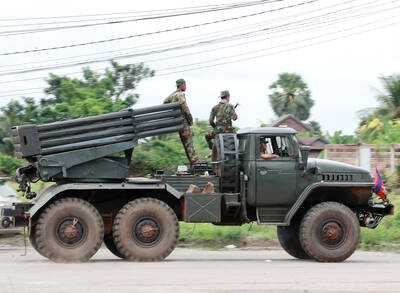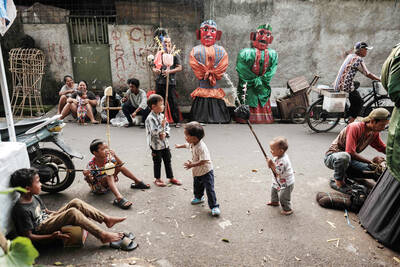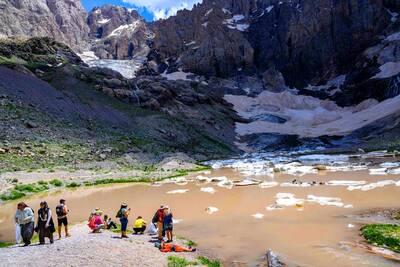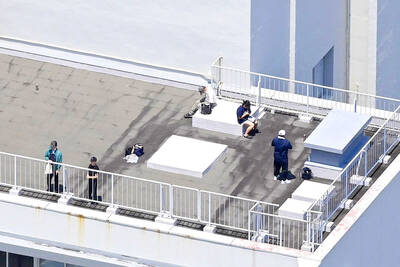Its scarred lion, “Marjan,” was for years a symbol of Afghan survival.
Now, more than a decade after his death, Afghanistan remains battered by war, but Kabul Zoo is buzzing again — a haven for women, children and young lovers in a capital city that has little public space for anyone but men.
The carnival of animal life might be a mundane affair compared with other places, but it seems like an anomaly in Kabul, a war-scarred city benighted by post-traumatic stress, which still faces a high risk of insurgent attacks.

Photo: AFP
Men with children, women in blue burqas, crowds of young students — girls and boys — come to this haven to relax.
“My wife and I have come here to take a break and forget our pain and sorrows,” said Mohammad Ali Akbari, a resident of Ghazni Province, one of the worst hit by the Taliban insurgency.
“My wife is a bit sick. I brought her here so she can breathe fresh air and enjoy the normal things of life,” he added, as his wife gazed at a bear inside a cage.
Children peer through a wire mesh fence, amused by monkeys swinging their tails and frolicking from one tree to another, as some of them imitate their whoops and barks.
Loud music emanates from the zoo canteen near an aviary with pheasants and other birds, as families huddled in conversation around burgers, fries and canned sodas.
Other picnickers seek respite from the scorching afternoon heat under the shade of trees, while enjoying platters of cantaloupe, honeydew and watermelon.
Blushing young lovers sit on a bench opposite the gazelle cage, seeking an escape from prying eyes in a city where harassment is otherwise commonplace.
The Kabul Zoo — the only one in the country — is located in the heart of the Afghan capital, surrounded by a dense warren of muddy flat-topped houses.
Before the 1992-1995 civil war, the zoo was home to many exotic animals.
However, most of them were either killed or escaped as mortar rounds slammed into the zoo during fighting, leaving only a bear with a nose injured by children who jabbed it with a stick, a scattering of monkeys, an assortment of birds of prey — and Marjan, the showpiece lion who was blinded by a grenade blast in 1993.
Many of the smaller and tamer animals, such as sheep and goats, were stolen for food. More exotic creatures, such as rare species of birds, were sold on the black market or smuggled out of the country.
The zoo has since undergone a slow and painful reconstruction, now housing about 600 animals, many of them gifted by countries such as India and China.
“It is now more than a zoo,” said Aziz Gul Saqib, who has served as director for more than a decade.
“Families feel safe here. They see the zoo as a place for rejuvenation,” he said, adding that last year more than 700,000 people visited the zoo, including 50,000 students.
The zoo, he said, earned 17 million Afghanis (US$250,000) last year from ticket sales and other revenues, making it self-sustainable.
It is equipped with high-tech surveillance cameras and loudspeakers — often used to chide those who tease the animals.
“It is very important to teach people about wildlife, because exotic animals in Afghanistan are on the verge of extinction,” Saqib said.
Marjan was seen as a symbol of Afghanistan’s national survival after living through coups, invasions, the grenade attack which scarred his face and blinded him, civil war and the hardline Taliban era which ended in 2001.
He died in 2002 and is buried in the zoo, but his bronze statue greets visitors at the entrance with many visitors posing beside it for selfies and photographs.
A new Marjan made headlines around the world when AFP found him in 2014, living on the roof of a compound in the upmarket Taimani district of the capital.
Government inspectors took him from the owner as the lion’s health declined and brought him to the zoo.
He did not live — but as the conflict grinds on, the zoo itself has become a symbol of Afghan endurance.

POLITICAL PATRIARCHS: Recent clashes between Thailand and Cambodia are driven by an escalating feud between rival political families, analysts say The dispute over Thailand and Cambodia’s contested border, which dates back more than a century to disagreements over colonial-era maps, has broken into conflict before. However, the most recent clashes, which erupted on Thursday, have been fueled by another factor: a bitter feud between two powerful political patriarchs. Cambodian Senate President and former prime minister Hun Sen, 72, and former Thai prime minister Thaksin Shinawatra, 76, were once such close friends that they reportedly called one another brothers. Hun Sen has, over the years, supported Thaksin’s family during their long-running power struggle with Thailand’s military. Thaksin and his sister Yingluck stayed

In the sweltering streets of Jakarta, buskers carry towering, hollow puppets and pass around a bucket for donations. Now, they fear becoming outlaws. City authorities said they would crack down on use of the sacred ondel-ondel puppets, which can stand as tall as a truck, and they are drafting legislation to remove what they view as a street nuisance. Performances featuring the puppets — originally used by Jakarta’s Betawi people to ward off evil spirits — would be allowed only at set events. The ban could leave many ondel-ondel buskers in Jakarta jobless. “I am confused and anxious. I fear getting raided or even

Kemal Ozdemir looked up at the bare peaks of Mount Cilo in Turkey’s Kurdish majority southeast. “There were glaciers 10 years ago,” he recalled under a cloudless sky. A mountain guide for 15 years, Ozdemir then turned toward the torrent carrying dozens of blocks of ice below a slope covered with grass and rocks — a sign of glacier loss being exacerbated by global warming. “You can see that there are quite a few pieces of glacier in the water right now ... the reason why the waterfalls flow lushly actually shows us how fast the ice is melting,” he said.

Residents across Japan’s Pacific coast yesterday rushed to higher ground as tsunami warnings following a massive earthquake off Russia’s far east resurfaced painful memories and lessons from the devastating 2011 earthquake and nuclear disaster. Television banners flashed “TSUNAMI! EVACUATE!” and similar warnings as most broadcasters cut regular programming to issue warnings and evacuation orders, as tsunami waves approached Japan’s shores. “Do not be glued to the screen. Evacuate now,” a news presenter at public broadcaster NHK shouted. The warnings resurfaced memories of the March 11, 2011, earthquake, when more than 15,000 people died after a magnitude 9 tremor triggered a massive tsunami that